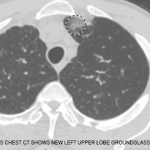To help answer these questions, Dr. Pagnoux said, “We need randomized controlled trials.”
More recently, researchers assessed patients who had remission induced with rituximab or cyclophosphamide and were then randomized after azathioprine treatment to either the monoclonal antibody belimumab or placebo. There was no significant difference between the groups in time to first relapse.8
The search for biomarkers to help individualize treatment remains a worthwhile effort, he said, but for now GPA or MPA hold the most important distinction, with GPA patients tending to feature a higher relapse risk.
“I think we have to admit that at this time, the most practical predictor of relapse is a basic, simple, clinical one,” he said.
Imperfect information leaves clinicians to make sometimes difficult decisions, he said. What, for example, should clinicians do about patients whose ANCA titers are persistent or increase during follow-up, and who historically relapse at about a 60% rate compared with 40% for those who stay ANCA negative?
“Is that difference enough to adjust, qualify or adapt the treatment? I’ll leave that to you to make your own decision,” he said. “The dream to individualize treatment based on genetics or some other biomarker is a commendable dream and, hopefully, will come to fruition soon, in a cost-effective manner.”
EGPA Treatment Research
Eosinophilic granulomatosis with polyangiitis (EGPA), or the Churg-Strauss syndrome, is a rare and little-studied form of ANCA-associated vasculitis, but one that should remain on the radar screen of rheumatologists, said Michael Wechsler, MD, director of the National Jewish Health Cohen Family Asthma Institute in Denver.
“The key issue for rheumatologists to recognize is that when you see eosinophilia [with counts of 1,000 or higher], you should think about EGPA,” he said.
EGPA encompasses a constellation of symptoms, including asthma, peripheral blood eosinophilia, mononeuropathy or polyneuropathy, pulmonary infiltrates, paranasal sinus abnormalities, extravascular eosinophils and ANCA positivity.
The disease often starts as an allergic rhinitis that becomes asthma, progresses to eosinophilic infiltration in the organs and then progresses to necrotizing vasculitis and granuloma formation. He tells patients to be wary of organ involvement (including neuropathy or GI symptoms) when he sees someone with asthma and eosinophilia. “I question them very heavily,” he said.
Steroids can usually control symptoms, but not always, and of course, they come with a litany of side effects even when they do work, Dr. Wechsler said. Other EGPA therapies are needed.
A 2017 study found that adding azathioprine to steroids didn’t reduce treatment failure, relapse rate or steroid use, and didn’t improve asthma or sinus problems.9


